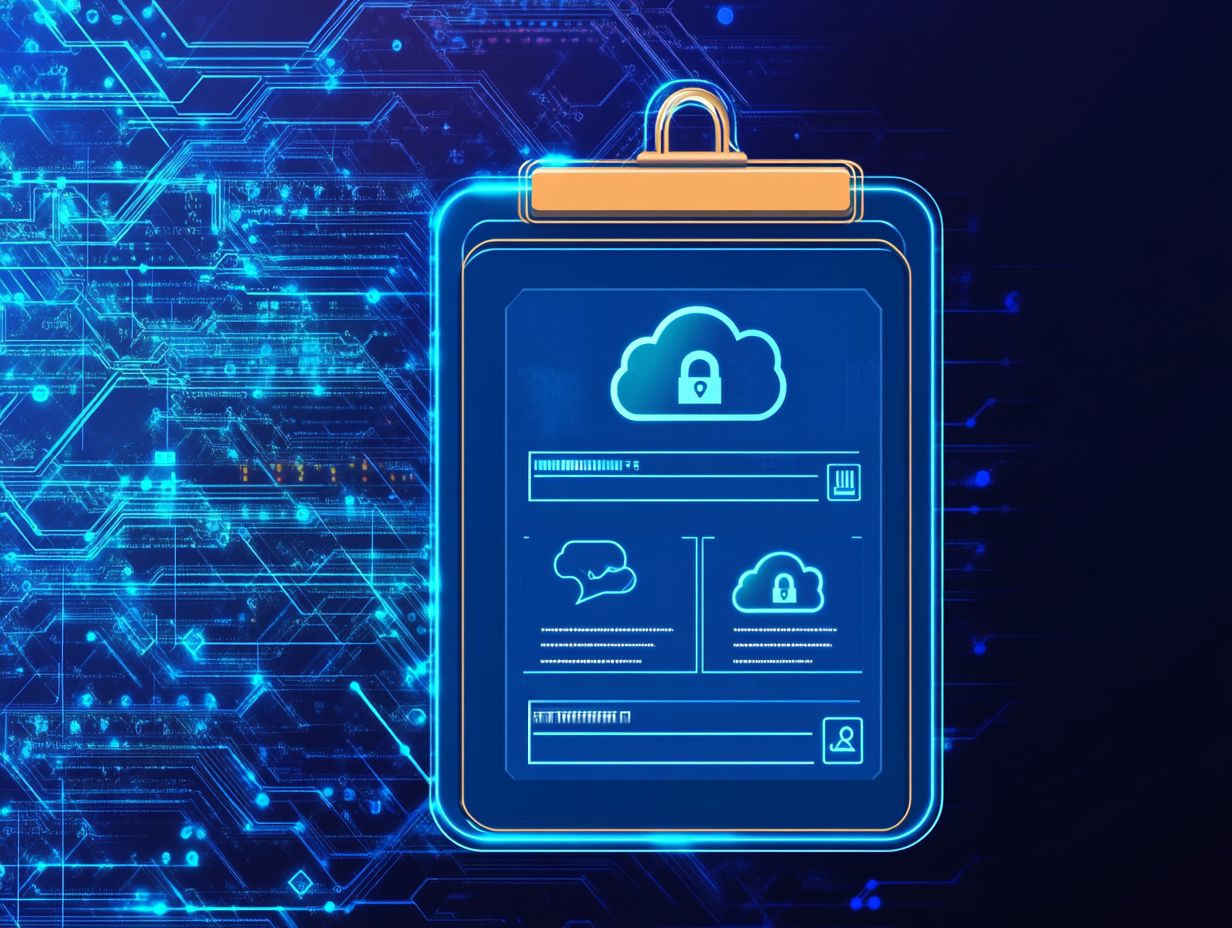5 Steps to Create a Cloud Security Policy
In today s digital landscape, protecting sensitive data in the cloud is more important than ever! With the rising tide of threats and vulnerabilities, crafting a robust cloud security policy has become a top priority for any organization.
This article presents a clear five-step approach designed to help you identify potential risks, set your security objectives, define roles, implement effective measures, and maintain an up-to-date policy.
You ll explore the key components and best practices for creating a comprehensive cloud security policy, ensuring compliance while steering clear of common pitfalls. Let s dive in and discover how to supercharge your cloud security today!
Contents
- Key Takeaways:
- 1. Identify Potential Risks and Threats to Your Cloud Environment
- 2. Establish Security Objectives and Goals
- 3. Define Roles and Responsibilities
- 4. Implement Security Measures
- 5. Regularly Review and Update Your Cloud Security Policy
- What Is a Cloud Security Policy and Why Is It Important?
- What Are the Key Components of a Cloud Security Policy?
- What Are the Best Practices for Creating a Cloud Security Policy?
- How Can Businesses Ensure Compliance with Their Cloud Security Policy?
- What Are the Common Mistakes to Avoid When Creating a Cloud Security Policy?
- How Can a Business Continuously Improve Their Cloud Security Policy?
- Preguntas Frecuentes
- Descubre los 5 Pasos Clave para tu Pol tica de Seguridad en la Nube!
- Por qu es importante tener una Pol tica de Seguridad en la Nube?
- C mo identifico mis requisitos de seguridad?
- Cu les son algunos componentes importantes a incluir en una Pol tica de Seguridad en la Nube escrita?
- Con qu frecuencia debe revisarse una Pol tica de Seguridad en la Nube?
- Se puede implementar una Pol tica de Seguridad en la Nube en cualquier industria?
Key Takeaways:
- Identify potential risks to protect your data.
- Establish clear security objectives.
- Regularly update your security policies.

1. Identify Potential Risks and Threats to Your Cloud Environment
Identifying potential risks and threats to your cloud environment is essential for crafting a robust cloud security strategy that not only protects your data but also ensures compliance with regulatory standards. This diligence safeguards your organization s critical assets from evolving security risks that could have severe consequences.
As you navigate the landscape of cloud platforms, you’ll encounter many security challenges. Human errors can unintentionally expose sensitive data, while a growing array of cyber threats from malware to sophisticated hacking attempts lurks in the shadows.
Weaknesses in your system, such as unpatched software or misconfigured settings, can create tempting entry points for attackers. Adopting a proactive approach that includes thorough threat analysis and regular risk assessments will give you the power to identify these vulnerabilities more effectively.
This not only enhances your understanding of the potential impact of various risks but also facilitates the formulation of effective mitigation strategies, ultimately strengthening your overall security posture.
2. Establish Security Objectives and Goals
Establishing clear security objectives and goals is essential for enhancing your organization s security posture, effectively managing risks, and ensuring alignment with compliance standards such as ISO 27001:2022, which is an international standard for information security management, and GDPR, a regulation that protects personal data in the EU.
These objectives should be specific, attainable, and measurable, enabling you to assess their effectiveness over time. By concentrating on risk reduction, you can prioritize the vulnerabilities that pose the greatest threat, ensuring that your resources are allocated efficiently.
Regularly evaluating compliance is crucial, as it allows you to reflect any regulatory changes that might impact your security protocols.
It s vital to recognize the need for regularly updating your security policies to respond to evolving threats, fostering an agile security environment that keeps up with the ever-changing digital landscape.
3. Define Roles and Responsibilities
Defining clear roles and responsibilities within your organization is essential for effective incident management and ensuring that security controls are enforced appropriately by employees at all levels. This clarity gives the power to your IT teams to implement and monitor security measures with precision, while compliance officers can ensure that regulatory obligations are met without any ambiguity.
When everyone knows exactly what s expected of them, end-users can serve as the first line of defense, spotting potential threats and following established protocols. Well-defined roles foster accountability and significantly enhance your organization s overall security posture by minimizing gaps and overlaps in responsibility.
A collaborative effort across these roles nurtures a culture of security awareness, leading to greater compliance with policies and a more robust security framework.
4. Implement Security Measures

Implementing robust security measures is essential for safeguarding your cloud data and applications against a wide array of threats. By leveraging advanced cloud security tools and effective access management strategies, you can strengthen your security.
Additionally, you can elevate your security posture by incorporating automated compliance checks. These checks systematically verify that you adhere to industry standards and regulations, ensuring you remain compliant.
Monitoring tools are crucial, offering real-time insights into system activities and enabling you to swiftly detect potential vulnerabilities or breaches. Stringent access controls will ensure that only authorized personnel can interact with sensitive information.
When you implement these measures cohesively, you create a strong security system that not only secures your infrastructure but also significantly reduces the risk of security incidents. This provides peace of mind in today s complex digital landscape.
5. Regularly Review and Update Your Cloud Security Policy
Regularly reviewing and updating your cloud security policy is paramount for staying ahead of the ever-evolving threat landscape and ensuring compliance with the latest security requirements and best practices.
This proactive approach helps you spot vulnerabilities quickly within your existing framework and empowers you with the insights necessary to bolster your defenses against emerging threats.
Engaging in periodic security assessments and audits reveals gaps that may have surfaced over time, enabling timely interventions.
By integrating automated compliance tools, you can significantly streamline this process while enjoying real-time monitoring and analysis.
This not only keeps your security policy relevant but also ensures it’s effective, ultimately safeguarding sensitive data and maintaining trust with your stakeholders.
What Is a Cloud Security Policy and Why Is It Important?
A cloud security policy lays the groundwork for protecting your cloud data and applications. It addresses essential security controls and compliance standards necessary for maintaining a robust security posture, including strategies for effective cloud security management to safeguard your organizational assets.
This policy serves several critical functions, primarily focusing on data protection through measures that detect, prevent, and respond to potential threats. You stand to gain significantly from a comprehensive approach to risk management, as it helps identify vulnerabilities within your processes and establishes protocols to effectively mitigate those risks.
A well-defined policy also ensures that you adhere to regulatory compliance, guiding you through the maze of laws and regulations governing data handling and security.
Having these policies is absolutely vital! They enhance your security practices and build trust with stakeholders by demonstrating your commitment to protecting sensitive information in today s increasingly complex digital landscape.
What Are the Key Components of a Cloud Security Policy?
The key components of a cloud security policy include access management protocols, security controls, and strict adherence to compliance standards, all designed to protect sensitive data and applications hosted in the cloud. To create an effective strategy, it’s crucial to understand how to build a cloud security culture.
These elements work together to mitigate risks and strengthen your overall security framework. For example, effective user account management is essential, as it dictates who can access your data, helping to thwart unauthorized breaches.
Data encryption ensures that sensitive information remains private, even if someone tries to steal it. Well-defined incident response procedures empower you to act swiftly in the event of a security breach, significantly minimizing potential damage.
Every aspect of this policy plays a crucial role in fostering a robust and resilient environment in the cloud.
Take action now to secure your cloud environment and protect your valuable data!
What Are the Best Practices for Creating a Cloud Security Policy?

Following best practices when creating a cloud security policy is crucial. This ensures strong security measures and effective risk assessments, such as the 5 steps to secure your cloud environment.
Involve key stakeholders in the development process. Diverse perspectives help align everyone on security goals.
Regularly update your policies to keep pace with new technologies and regulations. This keeps your strategies relevant and effective.
Conduct penetration tests to find hidden vulnerabilities. This allows you to fix problems before they become serious risks.
Stay adaptable to emerging threats. Continuous improvement is essential to safeguard your organization in the fast-changing cybersecurity landscape.
How Can Businesses Ensure Compliance with Their Cloud Security Policy?
Verify compliance with regular third-party audits and relevant regulatory standards. These practices ensure your security measures are effectively enforced.
Audits help find gaps in your security protocols. They offer an objective view of how well your measures are performing.
Align your policies with industry regulations like PCI DSS and NIST standards. This builds trust with clients and minimizes risks associated with data breaches.
What Are the Common Mistakes to Avoid When Creating a Cloud Security Policy?
Organizations often encounter pitfalls when creating a cloud security policy. Common issues include poor risk management, lack of employee training, and outdated policies. To avoid these challenges, it’s vital to implement strategies for secure cloud migration.
Conduct thorough risk assessments to spot vulnerabilities. Engaging employees in policy development can reveal practical security challenges.
Hold regular training sessions to keep your team informed about threats and best practices. Periodic reviews will help your policy adapt to evolving cybersecurity risks.
Encouraging continuous learning fosters a culture of security awareness. This significantly enhances your cloud security strategies.
How Can a Business Continuously Improve Their Cloud Security Policy?
Enhance your cloud security policy with regular assessments and automated checks. Refine your incident response plans based on past experiences.
This proactive method identifies weaknesses and builds a resilient culture. Establish feedback loops to analyze incidents and extract valuable insights for future strategies.
Adopt the latest technologies, like encryption and machine learning. These tools help you stay ahead of potential threats.
Engage with industry peers to share knowledge. This collaboration allows you to benchmark your practices against others successfully.
Preguntas Frecuentes

Descubre los 5 Pasos Clave para tu Pol tica de Seguridad en la Nube!
Los 5 pasos para crear una Pol tica de Seguridad en la Nube son:
- Identificar tus requisitos de seguridad.
- Evaluar tus medidas de seguridad actuales.
- Determinar los controles de seguridad en la nube apropiados.
- Crear un documento de pol tica por escrito.
- Implementar y revisar regularmente la pol tica.
Por qu es importante tener una Pol tica de Seguridad en la Nube?
Una Pol tica de Seguridad en la Nube es crucial. Establece pautas y procedimientos para asegurar datos sensibles.
Adem s, protege contra amenazas de hackers. Asegura que todos los empleados sean conscientes de sus responsabilidades y entiendan c mo proteger los datos en la nube.
C mo identifico mis requisitos de seguridad?
Para identificar tus requisitos de seguridad, eval a las necesidades de tu organizaci n y los riesgos potenciales.
Considera factores como el tipo de datos que manejas y las regulaciones de cumplimiento. Esto ayudar a determinar el nivel de medidas de seguridad necesarias para proteger tus datos.
Cu les son algunos componentes importantes a incluir en una Pol tica de Seguridad en la Nube escrita?
Algunos componentes importantes son:
- Una definici n clara de datos sensibles.
- Roles y responsabilidades de los empleados, como designar un responsable de la seguridad.
- Pautas para el acceso y almacenamiento de datos.
- Procedimientos de cifrado y copia de seguridad de datos.
- Plan de respuesta a incidentes.
- Proceso de revisi n y actualizaci n regular.
Con qu frecuencia debe revisarse una Pol tica de Seguridad en la Nube?
Una Pol tica de Seguridad en la Nube debe revisarse al menos una vez al a o. Es fundamental asegurarse de que est actualizada y sea efectiva.
Si hay cambios significativos en tu organizaci n o en el proveedor de servicios en la nube, la pol tica debe revisarse y actualizarse en consecuencia.
Se puede implementar una Pol tica de Seguridad en la Nube en cualquier industria?
S , se puede implementar en cualquier industria que maneje datos sensibles y utilice servicios en la nube.
Es vital que todas las organizaciones, independientemente de la industria, tengan medidas en su lugar para proteger sus datos y prevenir ataques cibern ticos.
Empieza a crear tu Pol tica de Seguridad en la Nube hoy para proteger tu organizaci n!






